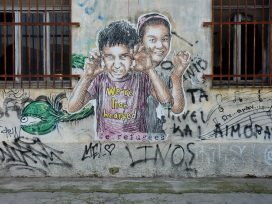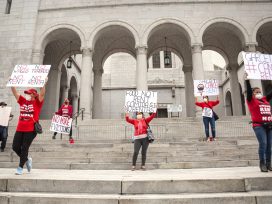Media pluralism is one of the themes that crops up regularly around discussion tables in the UK and across Europe. Although it is notoriously difficult to define media pluralism, it includes issues as diverse as guaranteeing the availability of a broad range of programming genres, ensuring a range of providers that meet the standards of impartiality, accountability and editorial independence, factors such as quality, experimentation, transparency, access and choice. The digital world offers an abundance of programmes, the ability to choose between different providers and diversity of individual choice, but as communities become more fragmented there is some question of how these public values will be preserved.
Indeed, digital switchover, already underway in some areas of the UK, raises many questions. Will increased channel competition result in an overall decrease of programming plurality and original production? A main part of the article is devoted to exploring alternative methods for delivery of public service (PS) output, including wider distribution of the license fee known as “top-slicing”, industry levies, regulatory asserts and so on. If top-slicing the license fee means a weaker BBC, is that acceptable? Should we be thinking of alternative mechanisms such as industry levies?
To what extent are concerns in the UK reflected across Europe? What is the state of plurality of PS providers and PS programming outside the UK? In most EU countries PSB is still primarily defined in terms of “internal pluralism”, meaning that the majority of European countries have mainly focused on pluralism within the PSB, rather than between different providers. Nor does PSB as an institution always have the history and credibility of the BBC, let alone the respect that is, to a large degree, taken for granted in the UK.
In the UK, the regulator Ofcom (Office of Communications) has undertaken two PSB reviews since the passing of the 2003 Communications Act. The first review – entitled Is Television Special? – took place in 2004 and considered terrestrial PSB would have difficulty surviving the digital switchover. It concluded that the license fee-funded BBC was likely to remain the sole provider of PSB. In its second review, Putting Viewers First, in January 2009, Ofcom set out recommendations for the future of PSB. The review identified a number of challenges and opportunities confronting the current PSB system. These included: the transition from analogue to digital; the fact that audiences value PS content and want it sustained; and that they want choice beyond the BBC.
Given the value the public placed on PSB and the critical importance of plurality – defined as competition in the provision of public service content – Ofcom’s main recommendations to government were to maintain the BBC’s role and funding at the heart of the system; free-up ITV and Five as commercial networks with a limited PS commitment; create a strong, alternative PS voice to the BBC with Channel 4 at its heart. It can be seen that propositions include “institutional” competition for PS provision to end the BBC’s near monopoly in the area, competition in the provision of PS programming, and “contestable” funding, income “top-sliced” from the licence fee and distributed to a wider range of PSBs in addition to the BBC. These propositions were echoed in the Digital Britain report published by the Department for Culture, Media and Science in 2009.
A European comparison
Traditionally, the UK has had a multiplicity of PS providers and programming, but as Ofcom’s analysis indicates it will be hard for commercially-funded broadcasters to sustain their PS obligations. This has initiated a debate on whether institutional competition and/or contestability in funding would provide adequate answers to the anticipated shortage of PS programming in the digital age. This debate has gathered pace in the UK without anyone asking whether the historic situation was unique to the UK, whether it is coming under pressure everywhere, and whether the current UK preoccupation is generally held or is peculiar to the UK debate.
With the precondition that one refers to broadcasting serving and competing in the same market, Ofcom’s concern that there should be more than one PSB seems to be unique. True, in countries such as Belgium, Switzerland and Spain, for a variety of historical, cultural or linguistic reasons, more than one PSB organization has been established, but these broadcasters normally serve different communities. For example, in Switzerland, different PSBs serve the German, Italian and French communities and another one the local dialect, while in Belgium, different PSBs cover the Flemish- and French-speaking communities. In Spain, public broadcaster RTVE serves the whole country and the seven regional broadcasters operate in various provinces, each serving only one province or autonomous community.
France Télévisions, the French public broadcaster, and Arte, the Franco-German cultural channel, do not testify to a plurality of PSBs since Arte was always meant to be a niche broadcaster. France 2 and France 3 are mainstream channels, but have, of course, been folded into the France Télévisions holding. The same applies to Greek TV broadcasters ET-1 (mainstream), NET (mainly news) and ET-3 (covering events in northern Greece), which operate under the auspices of ERT AE, the Greek unified broadcasting body.
In Poland, the largest eastern European country of around 22 million inhabitants, there are 19 PSBs (radio and TV separately at a national level, plus 17 regional public radio broadcasters, all in the name of devolution). Again, however, there are no equivalent broadcasters operating in the same market. During Sweden’s recent Public Service Review, chaired by MP Rose-Marie Frebran, the public broadcaster SVT was obliged to provide output for the whole country, across all genres, partly because it is only as part of such a broad output that its more specialized programmes can reach significant audiences.
Germany has a complicated system ensuring a plurality of PS institutions and this can be attributed to the fact that Germany is a federal state and broadcasting issues are by definition cultural issues and constitutionally the responsibility of the Länder (state). Germany maintains both a national channel and regionally focused ones for the preservation of plurality. The main PSBs, ARD and ZDF, serve the same national market; but while ZDF is a unified channel, today there are nine broadcasting corporations in the Länder that cooperate under the ARD umbrella, and each broadcast a third channel in their own Länder. In some cases there is one broadcaster in each Land (WDR for North-Rhine Westphalia), one for several Länder (NDR for Schleswig- Holstein, Mecklenburg-Vorpommern, Hamburg and Lower Saxony) in others, even one for a single town (RB for Bremen, an independent city). Later on, new PSBs were founded out of ARD and Mainz-based ZDF, namely Kika (a children’s channel), Phoenix (an information and documentary channel), 3sat (a cultural channel in cooperation with Austria and Switzerland) and Arte.
The French approach to PSBs also maintains both a national provider and regionally focused channels, but contrary to the German situation it has always been hard to secure provision of regional news and political coverage. PSB is undertaken by various public companies, established and regulated by the 1986 Law on Freedom of Communication. The main elements of the PSB mandate are contained in Article 1 of the Law, which provides, among other things, for the regulatory body CSA’s independence, the promotion of programme quality and diversity, and an emphasis on national audio-visual production to promote French language and culture. However, broadcast regulation has become a political football as a succession of different governments has substantially amended the CSA’s mandate and weakened its role.
In the smaller European country of Denmark, the only broadcaster with both public service obligations and licence fee funding is DR. Although the principles of PSB and DR itself are overwhelmingly supported, the channel faces major challenges relating to rising costs and its ability to reach young audiences. TV2, which is now privatized and funded by a mixed system of commercial and public funds, currently sees itself as a hybrid PSB-commercial broadcaster competing with both DR and the commercial sector for commercial resources and audience share. This is reflected in audience perceptions of it as more public service-oriented than other national commercial broadcasters – particularly in respect of its news output – and less independent than DR from government. Despite its privatization, TV2 must still abide by certain PS obligations with respect to news and current affairs and a continued financial commitment to Danish film.
As a study by the BBC Trust in 2009 noted, in Denmark, one of the principal difficulties of mixed public and commercial funding was demonstrated in a 2004 ruling by the European Commission, ordering TV2 to reimburse 84.4 million euros (plus interest) of “State aid”. The Commission found that with no evidence of TV2 having chosen not to maximize its advertising revenues whilst also in receipt of public funding, the “State compensation” it received between 1995 and 2002 exceeded the cost of fulfilling its public service obligations by 84.4 million euros. Alongside this difficulty, as we saw above, audience perceptions of TV2 reflect a degree of uncertainty over its role in Denmark’s broadcasting ecology.
In the Netherlands, the Scientific Council for Government Policy, in a 2005 report on future media policies, concluded that pluralism in the media should no longer be looked at in terms of a single medium, but instead should include the full supply of content and its use through other media, whether public or private, on the basis of important social functions. This could be interpreted as a new model for organizing the Dutch PSB based on a concept of “de-institutionalization” of PSB and “distributed public service”. The report also proposed to cancel entertainment as a core PSB task, thereby denying the importance of entertainment and hybrid output for the formation of public opinion, the dissemination of values and the construction of identity. The Council considered four possible models for the structure of PSB in the Netherlands, ranging from a model with no public service to a mixed and open model for public broadcast media. The Dutch debate reveals that there is no socio- political consensus on the future of PSB in the country.
Apart from Germany and Denmark, plus the ongoing Dutch debate, where there does indeed exist some form of competition between PSBs, there is little evidence that European countries aim for competition between broadcasters for the production and distribution of programmes in key PS genres. On the contrary, the majority of European countries aim for a unified public service system. In Sweden, for example, up to the end of 1995, the two public channels were competing openly with each other, with SVT1 showing Stockholm-based programmes and SVT2 broadcasting programmes from other parts of Sweden. In January 1997, the two channels were reorganized under a common administration and have since cooperated closely in the areas of production and broadcasting.
Even in Germany, fierce competitors ARD and ZDF occasionally coordinate their scheduling in order to avoid programming duplication. In fact, the kind of formalized cooperation which used to exist, with regular meetings to discuss programming issues or conflicts of interest for example, no longer exists. It simply does not work in a dual system of public and private, multi-channel television. However, since ARD and ZDF still jointly acquire rights in premium content such as sports – Olympics, Football World Cup – there is a need to cooperate at least in this important programming genre. As Runar Woldt put it, there are from time to time “gentlemen’s agreements” to avoid direct competition when it comes to expensive productions by any one of the operators. It should also be noted that ARD and ZDF are partners in several channels: Arte, 3sat, Kika, Phoenix. However, fierce competition between ARD and ZDF occurs in other cases, as both channels typically target audience groups not targeted by most of the private channels: older age groups, well-educated and information-oriented groups.
Plurality provision in Europe
Concern that the digital switchover and the intensified competition that accompanies it may force commercial PSBs to water down or give up their PS remit is certainly true in France, where PS plurality is hard to keep going, particularly as provision increases generally across television and audiences fragment. The PSB television sector is in very poor shape and is reeling from Sarkozy’s recent decision to take advertising away from PS channels. The French President is willing to end the public service channels’ partial dependence on advertising and turn them into purely non-commercial outfits. Advertising revenue brings in around ¤800m (US$1 billion) annually for France’s public channels, representing 40 per cent of their total budget. Although the President ruled out an increase in the licence fee, he nevertheless suggested compensating them for the shortfall by raising taxes on commercial broadcasters who would benefit from increased advertising revenues. Under this plan, France Télévisions relies more on the licence fee but has significantly fewer resources.
In Spain, there are no PS obligations for commercial broadcasters. The main concern is to ensure that RTVE really provides a PSB output: for the last decade, the first channel TVE-1 has been highly commercialized. The Spanish public broadcaster is plagued by chronic debt which has resulted in a most serious financial situation. It does not receive a licence fee but depends instead on commercial income and state grants, which are insufficient to cover its operational costs. To plug the deficit that ballooned soon after the arrival of commercial rivals, the public broadcaster has been relying on state-guaranteed loans, causing it to accumulate debt of around 8 billion euros. Most strikingly, RTVE is characterized by low-quality programming, news manipulation and the adoption of a programming strategy based on entertainment, to the detriment of culture and education. It has been openly criticized for not differentiating itself enough from its private competitors.
In Italy, too, non-PSBs are not obliged to provide PS content. Under a proposed policy shift, there might in future be a diminishing of RAI’s PS responsibilities (there is a suggestion that RAI’s two main channels be privatized and the third remain the only publicly funded channel), without, however, expanding its PS obligations to other players. This would certainly result in less pluralism. To get an idea of how Italians understand plurality, one has to refer to the system of lottizzazione that operated in Italy between the early-1970s and early-1990s. According to this, each channel, news and current affairs programmes, broadcast by RAI had different layers of political affiliation, with the intention of maintaining some diversity of output from “an otherwise monolithic broadcaster”.
In Germany, too, the commercial broadcasters are not subject to PS obligations. The German constitutional court even ruled on several occasions that private channels are allowed to be truly market oriented as long as PSB exists. It might be fair to say then that the presence of strong PSBs has allowed the relaxation of PS requirements for other providers.
Overall, there is little evidence in Europe to support the UK government’s idea, backed by Ofcom and the Digital Britain report, of setting up a competing body to offer programmes with public service output. In the UK there have traditionally been obligations for free-to-air terrestrial broadcasters to provide public service programming, and in the digital era there appears to be continuing demand for PSB to be produced and delivered by more than one source. Although ITV and Five have been partially released from the obligation to offer such output, Channel 4 has been envisaged as the channel to compete with the BBC in providing PS content. Elsewhere in Europe there is evidence of a decline in the range of PS output offered by free-to-air broadcasters, public or private. This may be the result of licence fee funding limits or of competition for dwindling advertising revenues, though there is no similarity to the UK policy development.
Why does it matter?
Publicly funded PSB retains its relevance in the digital universe so that citizens can have access to indigenous, high quality, diverse and pluralistic output. The availability of PS content online is moderate and selective; a study commissioned by Ofcom found that PSB categories such as arts, culture and heritage, children/teens, community and social action, learning and education are almost completely absent, whereas significant levels of PSB content are apparent in other areas such as information, search and reference, news and comment, business and commerce, entertainment and lifestyle, health, science and technology, and politics and government. Technological change and digital uptake have brought a large amount of audiovisual content to people, but most of that content is commercially oriented. In the UK, public service channels account for more than 90 per cent of all spending on original UK TV programming. Aside from BSkyB (through Sky News and the Arts Channel), the Discovery Network and the social networking site Bebo, which has made a small investment in original content, the majority of commercial media players in the UK invest little if anything in original content. Although the ways in which people access and consume PSB content may change, there is continued demand for PSB, as evidenced by the 2008 Ipsos MORI report.
Existing broadcasting institutions will certainly matter in delivering PS programming for the transition to digital, but there may need to be different models of intervention and funding if viewers are to retain access to specific types of PS output. Is institutional competition the answer? There are diverse points of view, but two things are certain: first, as the UK government acknowledges, “the market alone will not provide plurality in the ownership, commissioning, editorial and production of public service content that remains essential”; second, institutional competition for PS provision risks becoming unacceptable if this implies a weaker BBC, which remains the UK’s most powerful global brand and the most trusted source globally. There are more widely acceptable mechanisms to produce and disseminate PS content than top-slicing the licence fee, including regulatory assets and, above all, industry levies. The Institute for Public Policy Research (IPPR) report showed that direct media levies – levies charged on revenue from organizations such as broadcasters, cinemas or video labels and new media levies – charged on ISPs and mobile phone operators would suffice to bridge the funding gap identified by Ofcom and ensure the future of PSB in the UK. Digital switchover could also realize value from released spectrum previously used for broadcasting analogue TV signals.
The European dimension to the British debate about the future of the BBC and PSB more generally is underplayed and underdeveloped. In the UK, the BBC is taken for granted since it is perceived to be a cornerstone of PSB; there the debate largely focuses on plurality of institutions, plurality of channels and plurality of funding sources. In Italy, France or Spain, where little national discussion has taken place on the purposes of PSB (especially citizenship), content and funding methods, the public service ethos is less well-implemented and more susceptible to political attack.
The continental European emphasis on internal pluralism is at odds with the UK’s “external plurality” policy, under which all free-to-air terrestrial broadcasters have typically been given PS obligations. Even in the current multi-channel era, the UK government visualizes Channel 4 as the channel to carry a much-expanded remit alongside the BBC. It is clear that this is the essence of the UK’s “external plurality” policy, under which “institutional competition” ensures the continuing supply of PS content, thereby addressing the “public interest” issue in the digital age. In direct contrast, the continental European emphasis continues to be on “internal pluralism” as the most appropriate approach to maintain PS content.





